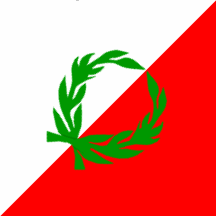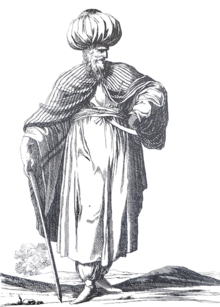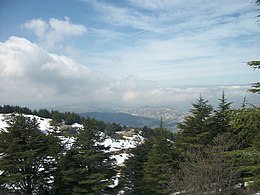Ma'n dynasty
The Ma'n dynasty (Arabic: الأسرة المعنية, romanized: Banū Maʿn, alternatively spelled Ma'an), also known as the Ma'nids, were an Arab family of Druze chiefs based in the Chouf area in southern Mount Lebanon who were politically prominent in the 12th and 15th–17th centuries.
| Ma'nids بنو معن | |
|---|---|
 Flag of the Ma'nid dynasty | |
| Country | Mount Lebanon Emirate, Ottoman Empire |
| Founded | 1120 (Chouf) |
| Founder | Fakhr al-Din I |
| Final ruler | Ahmed |
| Dissolution | 1697 |
| Historical Arab states and dynasties | ||||||||||||||||||||||||||||||||||||||||||||||||||||||||||
|---|---|---|---|---|---|---|---|---|---|---|---|---|---|---|---|---|---|---|---|---|---|---|---|---|---|---|---|---|---|---|---|---|---|---|---|---|---|---|---|---|---|---|---|---|---|---|---|---|---|---|---|---|---|---|---|---|---|---|
 | ||||||||||||||||||||||||||||||||||||||||||||||||||||||||||
|
Ancient Arab States
|
||||||||||||||||||||||||||||||||||||||||||||||||||||||||||
|
Arab Empires
|
||||||||||||||||||||||||||||||||||||||||||||||||||||||||||
|
Eastern Dynasties
|
||||||||||||||||||||||||||||||||||||||||||||||||||||||||||
|
Western Dynasties
|
||||||||||||||||||||||||||||||||||||||||||||||||||||||||||
|
Arabian Peninsula
|
||||||||||||||||||||||||||||||||||||||||||||||||||||||||||
|
East Africa
|
||||||||||||||||||||||||||||||||||||||||||||||||||||||||||
|
Current monarchies
|
||||||||||||||||||||||||||||||||||||||||||||||||||||||||||
Their authority began to rise with Fakhr al-Din I (d. 1506), who dominated the Chouf in the last years of Mamluk rule and reached its peak with Fakhr al-Din II (1572–1635). The latter's influence extended "from Antioch in the north to Tsfat (Safed) in the south."[1] Although Fakhr al-Din II's ambitions ended in his execution by Ottoman authorities, he greatly enhanced Lebanon's military and economic development. The dynasty's rule as Druze leaders in Mount Lebanon lasted until 1697.
Origins
Establishment in the Chouf
According to the historian Kamal Salibi, the "origins of the house of Ma'n remains unclear, what is related about it by the traditional Lebanese historians being without foundation".[2] The traditional account holds that the eponymous progenitor of the Banu Ma'n belonged to a clan of the Rabi'a, a large Arab tribal confederation with branches in the upper Euphrates River valley.[3] Ma'n fought alongside the Artuqid leader Ilghazi against the Crusaders in northern Syria.[3] He later moved to the Beqaa Valley until being transferred to the area of the Chouf (also transliterated as Shuf) in southern Mount Lebanon in 1120 by Ilghazi's ally, Toghtekin of Damascus, to reinforce the Tanukhid Druze emirs of the neighboring Gharb district around modern Aley against the Crusader lords of Beirut.[4][3][5] According to Salibi's analysis of the 19th-century history of Tannus al-Shidyaq, the deployment of the Ma'n was part of the wider deployment of Arab military settlers to parts of Mount Lebanon and its environs by the Muslim rulers of Damascus to counter the Crusaders.[6] The emirs of the Banu Shihab, an Arab family established in nearby Wadi al-Taym, collaborated with the Ma'nids against the Crusaders and from early on the two families established marital ties.[7]
The Crusaders had captured Beirut in 1110 and during their subsequent raids against the Gharb the Tanukhid emir Adud al-Dawla and most of his kinsmen were slain.[8] Ma'n had found the Chouf abandoned,[4] though there is no evidence of its desolation at the time, according to the historian Robert Brendon Betts.[9] The Tanukhid emir Buhtur, who was appointed commander of the Gharb by Damascus in 1147, supported the Ma'nid emir in constructing permanents dwellings for his clan in the Chouf.[5] The Ma'n were joined in the settlement of the Chouf by their north Syrian associates, the Abu Nakad and Talhuq clans.[4] Refugees from nearby areas taken over by the Crusaders migrated to the Chouf and numerous villages were founded, including the Ma'n's headquarter village of Baaqlin.[3] Baaqlin became a major center of the Druze faith,[3] and in the present day is the largest Druze locality in Lebanon.[9] Betts deems it improbable that the Banu Ma'n had been followers of "the Druze religion before coming into its sphere" in Mount Lebanon.[9] Ma'n died in 1148 and was succeeded as head of his clan by his son Mundhir.[3] According to the historian William Harris, the Banu Ma'n retained their lordship of the Chouf, as well as their ties to the descendants of Buhtur and the Banu Shihab, from their establishment in 1120 through the Mamluk era (1260–1516).[10]

A Ma'nid chief of the Chouf, Fakhr al-Din Uthman, also called Fakhr al-Din I to distinguish him from his better known descendant, was the first Ma'nid "whose historicity is beyond question", according to Salibi.[2] The Gharb-based Druze chronicler Hamza ibn Ahmad Ibn Sibat (d. 1520) refers to Fakhr al-Din Uthman as the "emir of the Ashwaf [plural of Chouf] in the region of Sidon" who died in August/September 1506.[11] The Damascene historian Shams al-Din Ibn Tulun (d. 1546) notes that a certain "Ibn Ma'n" was in the custody of the Mamluk governor of Damascus in 1498/99,[12] and an inscription in a mosque in Deir al-Qamar, a major village in the Chouf, credits "al-Maqarr al-Fakhri [the Fakhrid Seat] Emir Fakhr al-Din Uthman ibn al-Hajj Yunis ibn Ma'n" as the builder of the mosque in 1493.[11] Fakhr al-Din's construction of a mosque, which were not used by the Druze, and the honorific of al-Hajj attached to the name of his father Yunis indicates they were influenced by the major Druze religious reformer, their contemporary al-Sayyid al-Tanukhi (d. 1479), who advocated for Druze adoption of traditional Muslim rituals. They may also have represented attempts to gain favor with the Sunni Muslim Mamluk rulers.[11][13] The usage of the terms "emir" (commander) and al-Maqarr (an honorific for leading Mamluk officers or officials) suggest the Ma'nid chiefs held military commissions in the Mamluk army.[11][12] Fakhr al-Din's son Yunis was also called by Ibn Sibat the "emir of the Ashwaf" at the time of his death in 1511/12.[14] The accounts of Ibn Sibat indicate the Ma'n controlled all or parts of the Chouf before the Ottoman conquest of the Levant in 1516.[12]
Early relations with the Ottomans
Following the Ottoman conquest, the Chouf was administratively divided into three nahiyas (subdistricts) of the Sidon-Beirut Sanjak, which was a district of the Damascus Eyalet.[15] The Chouf subdistricts, along with the subdistricts of Gharb, Jurd and Matn were predominantly populated by Druze at the time.[15] The Ottoman sultan Selim I, after entering Damascus and receiving the defection of its Mamluk governor Janbirdi al-Ghazali, who was kept in his post, showed preference to the Turkmen Assaf clan, the Keserwan-based enemies of the Ma'nids' Buhturid allies, entrusting them with political authority or tax-farming rights in the subdistricts between Beirut and Tripoli, north of the Druze areas.[16] The Buhturid emir Jamal al-Din Hajji did not give allegiance to Selim in Damascus and after discarding an Ottoman call to arms in 1518, he was imprisoned.[17] The son of the Ma'nid emir Yunis, Qurqumaz, was summoned and confirmed by Selim in Damascus as the chief of the Chouf in 1517, according to the 17th-century historian and Maronite patriarch Istifan al-Duwayhi.[14] Ibn Sibat does not mention any Ma'nid being received by the sultan in Damascus,[18] but noted that the Ma'nid emirs Qurqumaz, Alam al-Din Sulayman and Zayn al-Din were all arrested by Janbirdi al-Ghazali in 1518 and transferred to the custody of Selim, who released them after a heavy fine for supporting the rebellion of the Bedouin Banu al-Hansh emirs in Sidon and the Beqaa Valley.[19]

The three Ma'nids likely shared the chieftainship of the Chouf, though the length and nature of the arrangement is not known.[19] Zayn al-Din is assumed by the modern historian Abdul-Rahim Abu-Husayn to be the "Zayn Ibn Ma'n" mentioned in an Ottoman register as the owner of a dilapidated watermill with two millstones in 1543, while Ibn Tulun's reference to a part of the Chouf as "Shuf Sulayman Ibn Ma'n" in 1523 likely refers to Alam al-Din Sulayman.[20] Neither Zayn nor Sulayman are mentioned by later chroniclers of the Ma'nids, likely for political reasons related to the chroniclers' association to the Ma'nid line of Qurqumaz.[21] The latter was based in the Chouf village of Baruk, where he gave refuge to members of the Sayfa family after their flight from Akkar in 1528.[20] Qurqumaz's establishment in Baruk instead of his predecessors' apparent seat in Deir al-Qamar may have been related to a conflict with Alam al-Din Sulayman, who may have controlled Deir al-Qamar at the time,[22] or a division of the Chouf between the Ma'nid chieftains.[20]
In 1523 forty-three villages in Shuf Sulayman Ibn Ma'n, including Baruk, were burned by the forces of the Damascus governor Khurram Pasha for tax arrears and Ma'nid disobedience, and the governor's forces sent back to Damascus four cartloads of Druze heads and religious texts in the aftermath of the campaign.[23][24] According to Harris, "such brutality entrenched [Druze] resistance",[24] and in the following year Druze fighters killed subashis (provincial officials) appointed by Khurram Pasha to administer Mount Lebanon's subdistricts, prompting another government expedition against the Chouf, which returned three cartloads of Druze heads and three hundred women and children as captives.[23] The death of Jamal al-Din Hajji in prison in 1521 and the Ottoman expeditions led the Buhturids to accept Ma'nid precedence over the Druze of southern Mount Lebanon.[24] In 1545 the leading emir of the Druze, Yunis Ma'n, was lured to Damascus and executed by the authorities under unclear circumstances, but suggesting continued insubordination by the Druze under Ma'nid leadership.[23]
Following the death of Yunis, the Druze moved to import from the Venetians long-range muskets superior to those employed by the Ottomans.[25] In 1565 the new arms were put to use by the Druze in an ambush on Ottoman sipahi (fief-holding cavalries) in Ain Dara in the Jurd sent to collect taxes from southern Mount Lebanon.[26] For the next twenty years, the Druze successfully beat back government attempts to collect taxes and confiscate weapons, while increasing their rifle arsenals.[26] The imperial authorities organized a much larger campaign against the Chouf and the Sidon-Beirut Sanjak in general in 1585 led by the beylerbey (provincial governor) of Egypt, Ibrahim Pasha.[26] It ended in a decisive government victory, the confiscation of thousands of rifles and the collection of tax arrears, which had been accruing for decades, in the form of currency or property.[26] The most important leader in the Chouf at the time was a Ma'nid emir named Qurqumaz, possibly the son of Yunis,[27][lower-alpha 1] and possibly the grandson of the above mentioned Qurqumaz.[2] He had likely been the chieftain of the specific area of the Chouf referred to as "Shuf Ibn Ma'n", a subdistrict mentioned in Ottoman government documents from 1523, 1530, 1543 and 1576.[31] His preeminence among the Ma'nids was possibly the result of the natural deaths or eliminations of the other Ma'nid chiefs.[31] Like his father, Qurqumaz was a multazim (tax farmer) in the Chouf, though he resided in Ain Dara, and was recognized as a muqaddam of the Druze, his title of "emir" being used by local historians as a traditional honor rather than an official rank.[32] Qurqumaz had refused to submit to Ibrahim Pasha and escaped the Chouf and died soon after in hiding.[33][lower-alpha 2] The aftermath of the campaign and the death of Qurqumaz left the Druze areas in an anarchic state marked by internal fighting among the Druze.[33]
Rule of Fakhr al-Din II

As part of his policy to strengthen trade and political relations with Tuscany, Fakhr-al-Din II concluded a secret agreement with Ferdinando I de' Medici, Grand Duke of Tuscany, the two parties pledging to support each other against the Ottomans. Informed of this agreement, the Ottoman ruler in Constantinople reacted violently and ordered Hafız Ahmed Pasha, governor of Damascus, to attack Fakhr-al-Din. Realizing his inability to cope with the regular army of Hafız, the Lebanese ruler went to Tuscany in exile in 1613. He returned to Lebanon in 1618, after his good friend Silihdar Mehmed Pasha became governor of Damascus.
Following his return from Tuscany, Fakhr-al-Din, realizing the need for a strong and disciplined armed force, channeled his financial resources into building a regular army. This army proved itself in 1623, when Mustafa Pasha, the new governor of Damascus and the Harfush clan underestimated the capabilities of the Lebanese army, engaged it in battle and was decisively defeated at Anjar in the Biqa Valley.
In addition to building up the army, Fakhr-al-Din, who became acquainted with Italian culture during his stay in Tuscany, initiated measures to modernize the country. After forming close ties with the dukes of Tuscany and Florence and establishing diplomatic relations with them, he brought in architects, irrigation engineers, and agricultural experts from Italy in an effort to promote prosperity in the country.[35] He also strengthened Lebanon's strategic position by expanding its territory, building forts as far away as Palmyra in Syria, and gaining control of Palestine. Finally, the Ottoman sultan Murad IV of Constantinople, wanting to thwart Lebanon's progress toward complete independence, ordered Küçük Ahmet Pasha, then governor of Damascus, to attack the Lebanese ruler. This time Fakhr ad Din was defeated, and he was executed in Constantinople in 1635.[36]
Mulhim
| Part of a series on
Druze |
|---|
 |
|
Beliefs
|
|
Important figures |
|
Texts
|
|
Holy places |
|
Holy days |
|
Related topics
|
|
Fakhr-al-Din was succeeded in 1635 by his nephew Mulhim Ma'an, who ruled through his death in 1658. (Fakhr-al-Din's only surviving son, Husayn, lived the rest of his life as a court official in Constantinople.) Emir Mulhim exercised Iltizam taxation rights in the Shuf, Gharb, Jurd, Matn, and Kisrawan districts of Lebanon. Mulhim's forces battled and defeated those of Mustafa Pasha, Beylerbey of Damascus, in 1642, but he is reported by historians to have been otherwise loyal to Ottoman rule.[37]
Ahmad and Korkmaz
Following Mulhim's death, his sons Ahmad and Korkmaz entered into a power struggle with other Ottoman-backed Druze leaders. In 1660, the Ottoman Empire moved to reorganize the region, placing the sanjaks (districts) of Sidon-Beirut and Safed in a newly formed province of Sidon, a move seen by local Druze as an attempt to assert control.[38] Contemporary historian Istifan al-Duwayhi reports that Korkmaz was killed in act of treachery by the Beylerbey of Damascus in 1662.[38] Ahmad however escaped and eventually emerged victorious in the power struggle among the Druze in 1667, but the Maʿnīs lost control of Safad[39] and retreated to controlling the iltizam of the Shuf mountains and Kisrawan.[40] Ahmad continued as local ruler through his death from natural causes, without heir, in 1697.[39] During the Ottoman–Habsburg War (1683–1699), Ahmad Ma'n collaborated in a rebellion against the Ottomans which extended beyond his death.[39] Iltizam rights in Chouf and Kisrawan passed to the rising Shihab family through female-line inheritance.[40]
See also
Notes
- The identity of Qurqumaz's father is not definitively known. According to the historian Giovanni Minadoi (d. 1618), Qurqumaz's father, who Minadoi does not name, had been executed by a governor of Damascus named Mustafa Pasha. According to modern historian Abdul-Rahim Abu-Husayn, Qurqumaz's father may have been the "Yunis Ibn Ma'n" mentioned in an Ottoman tax register as the owner of three farms in 1530.[28] The modern historian Muhammad Adnan Bakhit holds this Yunis was likely the head of the Ma'nids at the time.[29] A Ma'nid chief named Yunis was recorded by the contemporary poet Muhammad ibn Mami al-Rumi (d. 1579) to have been captured and hanged by the Ottomans at an undefined date as a result of unspecified complaints by the qadi (head judge) of Sidon to the Sublime Porte.[28][30]
- According to the Maronite patriarch and historian Istifan al-Duwayhi (d. 1704), Qurqumaz was killed during a government expedition against the Chouf in 1585, precipitated by Qurqumaz's alleged orchestration of an attack the preceding year on a government convoy in Akkar that had been transporting the annual Egyptian tribute destined for the sultan in Constantinople.[34]
References
- Nisan 2002, p. 99.
- Salibi 1991, p. 343.
- Abu Izzedin 1993, p. 179.
- Harris 2012, p. 59.
- Harris 2012, pp. 58–59.
- Salibi 2005, pp. 116–117.
- Salibi 2005, p. 117.
- Harris 2012, p. 58.
- Betts 1988, p. 71.
- Harris 2012, p. 78.
- Salibi 1973, p. 277.
- Abu-Husayn 1985, p. 67.
- Salibi 2005, p. 123.
- Salibi 1973, p. 278.
- Abu-Husayn 1992, p. 666.
- Harris 2012, pp. 88–89.
- Harris 2012, p. 89.
- Salibi 1973, pp. 280–281.
- Abu-Husayn 1985, pp. 68–69.
- Abu-Husayn 1985, p. 69.
- Salibi 1973, p. 284.
- Salibi 1973, pp. 284–285
- Abu-Husayn 1992, p. 668.
- Harris 2012, p. 91.
- Abu-Husayn 1992, pp. 668–669.
- Abu-Husayn 1992, p. 669.
- Abu-Husayn 1985, pp. 67 note 3, 69–70.
- Abu-Husayn 1985, p. 70.
- Bakhit 1982, p. 164.
- Bakhit 1982, p. 165.
- Abu-Husayn 1985, p. 71.
- Abu-Husayn 1985, pp. 69, 71.
- Abu-Husayn 1992, p. 670.
- Salibi 1965, p. 749.
- The most recent and complete account of the life of Fakhr-al-Din is T. J. Gorton, Renaissance Emir: a Druze Warlord at the Court of the Medici (London: Quartet Books, 2013).
- http://lcweb2.loc.gov/cgi-bin/query/r?frd/cstdy:@field(DOCID+lb0024)
- Abu-Husayn 2004, pp. 21–22.
- Abu Husayn 2004, p. 22.
- Abu-Husayn 2004, pp. 22–23.
- Salibi 2005, p. 66.
Bibliography
- Abu-Husayn, Abdul-Rahim (1985). Provincial Leaderships in Syria, 1575-1650. Beirut: American University of Beirut.
- Abu-Husayn, Abdul-Rahim (November 1992). "Problems in the Ottoman Administration in Syria during the 16th and 17th Centuries: The Case of the Sanjak of Sidon-Beirut". International Journal of Middle East Studies. 24 (4): 665–675.
- Abu-Husayn, Abdul-Rahim (2004). The View from Istanbul: Lebanon and the Druze Emirate in the Ottoman Chancery Documents, 1546-1711. I.B. Tauris. ISBN 978-1-86064-856-4.
- Abu Izzedin, Nejla M. (1993) [1984]. The Druzes: A New Study of Their History, Faith, and Society (2nd ed.). Leiden and New York: Brill. ISBN 90-04-09705-8.
- Bakhit, Muhammad Adnan (1982). The Ottoman Province of Damascus in the Sixteenth Century. Librairie du Liban.
- Betts, Robert Brendon (1988). The Druze. New Haven and London: Yale University Press. ISBN 0-300-04100-4.
- Harris, William (2012). Lebanon: A History, 600–2011. New York: Oxford University Press. ISBN 978-0-19-518-111-1.
- Nisan, M. (2002). Minorities in the Middle East: A History of Struggle and Self-Expression. McFarland. ISBN 978-0-7864-1375-1.
- Salibi, K. (1991). "Maʿn". In Bosworth, C. E.; van Donzel, E. & Pellat, Ch. (eds.). The Encyclopaedia of Islam, New Edition, Volume VI: Mahk–Mid. Leiden: E. J. Brill. pp. 343–344. ISBN 90-04-08112-7.
- Salibi, Kamal S. (July 1973). "The Secret of the House of Ma'n". International Journal of Middle East Studies. 4 (3): 272–287.
- Salibi, Kamal S. (2005). A House of Many Mansions: The History of Lebanon Reconsidered. I.B. Tauris. ISBN 978-1-86064-912-7.
Further reading
- Abu-Husayn, Abdul-Rahim (1985). "The Ottoman Invasion of the Shūf in 1585: A Reconsideration". Al-Abhath. 32: 13–21.
